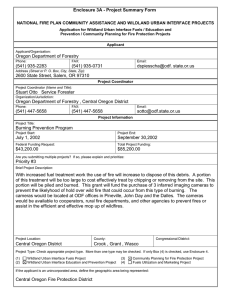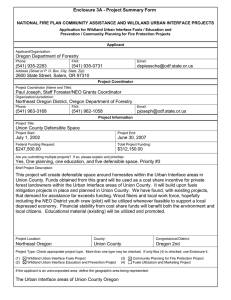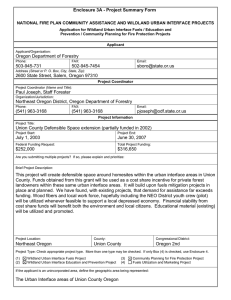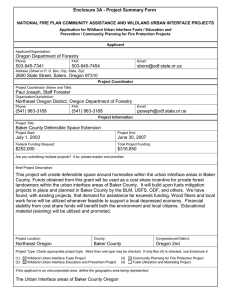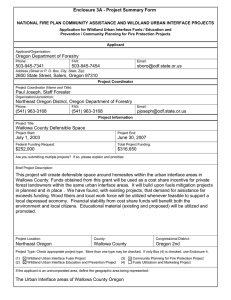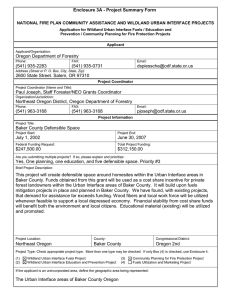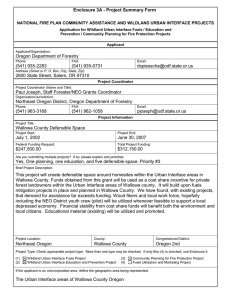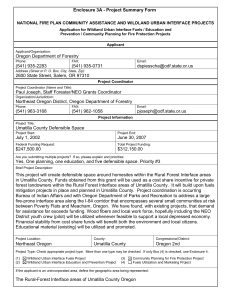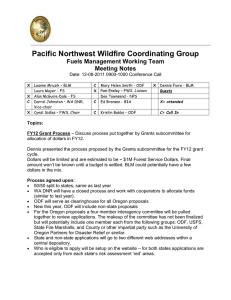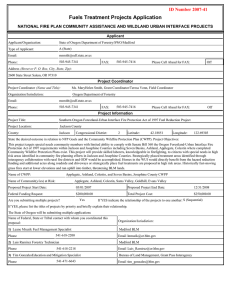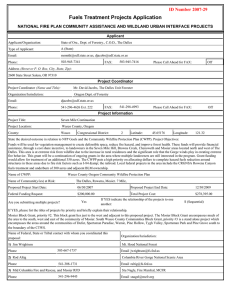104 Enclosure 3B - Project Summary Form Don Matlick
advertisement
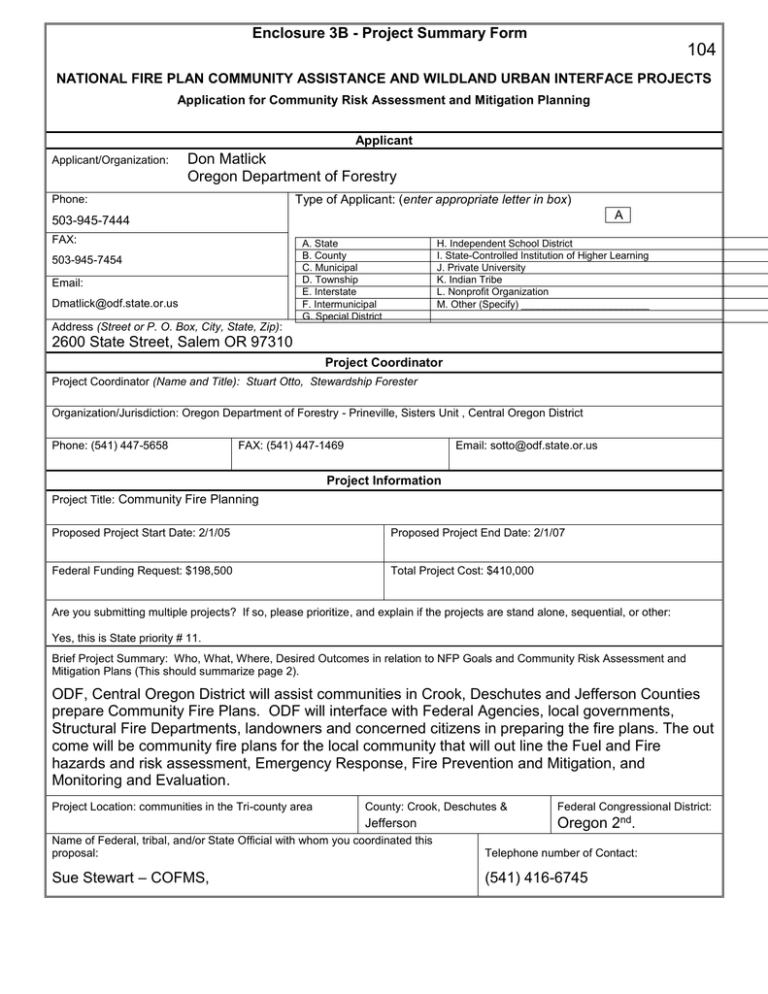
Enclosure 3B - Project Summary Form 104 NATIONAL FIRE PLAN COMMUNITY ASSISTANCE AND WILDLAND URBAN INTERFACE PROJECTS Application for Community Risk Assessment and Mitigation Planning Applicant Applicant/Organization: Don Matlick Oregon Department of Forestry Phone: Type of Applicant: (enter appropriate letter in box) A 503-945-7444 FAX: A. State B. County C. Municipal D. Township Email: E. Interstate Dmatlick@odf.state.or.us F. Intermunicipal G. Special District Address (Street or P. O. Box, City, State, Zip): C. Municipal 2600 State Street, Salem OR 97310 J. Private University H. Independent School District I. State-Controlled Institution of Higher Learning J. Private University K. Indian Tribe L. Nonprofit Organization M. Other (Specify) _______________________ 503-945-7454 Project D. Township Coordinator K. Indian Tribe Forester Project Coordinator (Name and Title): Stuart Otto, Stewardship E. Interstate Organization/Jurisdiction: Oregon Department of L. Forestry Sisters Unit , Central Oregon District Nonprofit- Prineville, Organization Phone: (541) 447-5658 Intermunicipal FAX: (541) F. 447-1469 Email: sotto@odf.state.or.us M. Other (Specify) _______________________ G. Special DistrictInformation Project Project Title: Community Fire Planning Proposed Project Start Date: 2/1/05 Proposed Project End Date: 2/1/07 Federal Funding Request: $198,500 Total Project Cost: $410,000 Are you submitting multiple projects? If so, please prioritize, and explain if the projects are stand alone, sequential, or other: Yes, this is State priority # 11. Brief Project Summary: Who, What, Where, Desired Outcomes in relation to NFP Goals and Community Risk Assessment and Mitigation Plans (This should summarize page 2). ODF, Central Oregon District will assist communities in Crook, Deschutes and Jefferson Counties prepare Community Fire Plans. ODF will interface with Federal Agencies, local governments, Structural Fire Departments, landowners and concerned citizens in preparing the fire plans. The out come will be community fire plans for the local community that will out line the Fuel and Fire hazards and risk assessment, Emergency Response, Fire Prevention and Mitigation, and Monitoring and Evaluation. Project Location: communities in the Tri-county area County: Crook, Deschutes & Federal Congressional District: Jefferson Oregon 2nd. Name of Federal, tribal, and/or State Official with whom you coordinated this proposal: Telephone number of Contact: Sue Stewart – COFMS, (541) 416-6745 Enclosure 3B (Page 1 of 3) - Project Narrative Description Applications for funding must include a narrative response that describes the proposal. Please do not submit responses longer than one page, single space, 12-pitch font. Describe project including, but not limited to: change fire behavior WHO are your collaborators - are they current or potential Address these through fuels reduction collaborators? items as increase community describe the relationship of this plan’s desired outcome to NFP Goals applicable: education and awareness and to any existing community fire protection plan. enhance fire protection project time frames and matching or contributed funds capability tools and/or skills needed to complete project desired outcome specific project location, geographic extent, and fire risk assessment methodology For this project, explain the level of cooperation, coordination or strategic planning, through a “Local Coordination Group.” If you haven’t worked with a local coordination group, why not? Under this proposal ODF will assist local communities prepare their Community Fire Plans. The Community Fire plan will follow an outline currently being developed by Sue Stewart and a group of Federal, State, County officials and local Fire Department and others, for the City of Bend. By the time this grant is funded this effort should be completed and we will known if this format will work in other communities. This planning effort will address Hazardous Fuels, emphasizing the protection of the community by treating hazardous fuels, including a description of existing conditions with a risk assessment, and identify the desired conditions to best protect the community and recommend the types and methods of hazardous fuel treatments. The plan will also examine Emergency Response, with the objective of developing a coordinated and integrated emergency response plan to address fire suppression in the wildland urban interface. The Emergency Response section will include, inventory of current capabilities, inventory of equipment, description of fire related infrastructure, summary of existing partnerships and agreements, and develop an integrated operation plan outlining response to fire emergencies including a system for reviewing capabilities and for making recommendations and suggestions to improve suppression capabilities. The Fire Prevention portion will develop a fire prevention strategy to address human activities and considerations in the context of wildland urban interface issues. Some of the elements addressed under fire prevention are: Establish a public education program, fire prevention engineering, fire restrictions, fire hazard remediation, and developing partnerships in fire prevention. The last area of the Plan will be Monitoring and Evaluation. The objective of this portion of the plan is to: Develop a monitoring plan to periodically evaluate the implementation of the plan and to monitor and assess results of the fire hazard mitigation and associate work. The collaborators will include Federal and State agencies, local governments, homeowner associations and local fire protection departments and landowners The federal , state, some local governments and local fire protection departments are currently working together on the Bend plan. There will be different players at different locations but most emergency management agencies will be represented with local landowners and others. Currently there are very few Community fire plans in Central Oregon but this planning effort will help those communities meet the goal of the National Fire Plan that communities have written strategy to begin building fire safe landscapes. We have proposed a two year time frame for this planning effort but by the end of the grant communities in three counties will have Community Fire Plans. Most of the matching funds will be from inkind contributions of individuals time from other agencies and Fire Departments with some volunteer time from Homeowner associations and landowners. Part of the grant will be to support an individual with the tools they will need to complete the planning effort. This support will include:a vehicle for travel with in the three county area, a laptop computer and applicable software to provide written documents and GIS support for the Community Fire Plan and a large format printer to produce large scale maps for public meetings and visual reference during planning meetings. Skills will include an understanding of fuels and vegetation management, good interpersonal skills, organizational skills and the ability to conduct efficient and effective planning and public meetings. The specific communities will vary the minimum number could be eight to ten if a larger geographic area can be planned in a single plan for example the LaPine basin, or the Sisters – Camp Sherman, Cloverdale area. If each community identified in the Federal register needs an individual plan than many more plans will need to be developed. The scope of this proposal is to group communities together in geographical areas for this planning purpose. Enclosure 3B (Page 2 of 3) - Project Evaluation Criteria Applications for funding, must include narrative responses that address the following four criteria. Be sure you address every one briefly, yet thoroughly. Limit your responses to the area provided. 1. Planning for Action (40 points) A. Describe your desired plan outcome and how the outcome will be measured. B. How will the plan address : Fire behavior changes through fuels reduction Community education and awareness Enhanced suppression capability C. How will the completed plan be implemented, and by whom? OR How does this plan enhance or complete previous fire planning by the community? D. How will the plan address landowner responsibility for implementation of this plan? E. Describe your ability to complete project in one year of receipt of funds The desired out come of this proposal is for communities in Central Oregon to have a written plan that will identify the fuel hazard and risk, help the community priorities treatment projects and implement mitigation practices. The out come will be measured by the plan’s monitoring and evaluation parameters. Fire behavior changes through fuels reduction will be in outlined in the plan’s hazardous fuels section, identifying desired condition in terms of , flame lengths, fuel continuity, condition class and fire regime. Community education and awareness will be addressed in the plan’s fire prevention section. Identifing fire prevention education standards, community fire prevention strategy. Media fire prevention education stategy. And by meeting with the landowners to out line fuels treatment practices they can use to make their property more fire safe. Enhanced suppression capability will be addressed in the plan’s emergency response section in addressing fire suppression capabilities of the combined Federal, State, and local Fire protection agencies and reviewing infrastructure developments and cooperative agreements and existing partnerships to strengthen emergency responses in the urban interface. Landowner responsibility for implementation of the plan is addressed in the Fuels portion of the plan by explaining options of fuel treatments and in the Fire Prevention portion of the plan by educating the landowners of their importance in doing the fuel reduction. The ability to complete the planning projects in one year will depend on the number of plans that must be completed. Response: 2. Enhancing Community Collaboration and Local Capacity. (30 points) A. Describe your strategy for collaboration to develop this plan across multiple ownerships. B. Identify the interested partners and members of the community who are involved in this project, and the level of their involvement. C. How will this project enhance local community collaboration and local capacity for cooperative action? D. Describe skills or experience the community will gain through development of this plan. The strategy for collaboration to develop this plan across multiple ownerships is to identify benefits of a collective effort to reduce fuels across ownership’s in reducing the cost and increasing the effectiveness of the treatments. The interested partners are the fuels planners and fire suppression personnel on the National Forests and Bureau of Land Management on Federal lands, Oregon Department of Forestry that has fire suppression responsibility on the private wildlands, Local Fire departments that have responsibility on private urban interface lands and the affected landowners, local County officials and Emergency Managers. Currently, the level of involvement is high for agency personnel and I believe that affected landowner interest will grow with the development of the plans. I believe that this project will enhance local communities collaboration in showing them that collaboration for a common problem or cause will improve their chances of resolving the problem or improving the situation. The skills or experience the community will gain through the development of this plan is skill to identify hazardous conditions and collaboratively agree on treatment program to improve the survivability of their community. Response: Enclosure 3B (Page 3 of 3) - Project Evaluation Criteria 3. A. B. C. D. E. Expanding Community Participation. (30 Points) Explain the level of cooperation, coordination and/or involvement of the Local Coordination Group. List the cooperators/members (in a broad way) of the local area coordination group. Describe your strategy for leveraging funding. Who are the partners and what is their commitment to the plan’s completion, including any existing or proposed cost-share agreements and their status. Describe the extent of local support or opposition for the project. Describe your strategy for post-plan marketing and collaboration for the successful implementation of the next steps described in the plan. To what extent will this project be offered to serve as a model for other communities in your sub-geographic area, state-wide area? Currently, there is no group identified as the local Coordination Group but there is the Central Oregon Fire Council. This group is made up of the Forest Supervisor of the Deschutes and Ochoco National Forests, the District Manager of the Prineville District for the Bureau of Land Management, The District forester of the Oregon Department of Forestry, Central Oregon District, State Fire Marshall, Deschutes County, Jefferson County and Crook County representatives. The level of cooperation and coordination is high. B. The strategy for leveraging funding is fair, the partners mostly consist of federal, State, County and local Fire Protection Districts with a few concerned consultants and landowners. Currently, most agencies are donating time in an inkind fashion There are no cost –share agreements at this time. C. Currently there is strong support among the partners and I feel will be strong support through the planning stages. If there will be any strong opposition I believe it will occur during the implementation phases. D. The post- plan marketing and collaboration will come after the planning identifies the fuels work to be done. I believe we can than approach landowners with a variety options to get the work done on those lands and may have several incentives available through programs under the National Fire Plan and other Farm Bill Programs for forestry . E. We hope to use this program across a Tri-county area to do community fire plans and it could be used in other counties in Oregon and other States. E. Response: Enclosure 3C - Project Work Form Tasks Time Frame Responsible Party Hire planner February 2005 ODF Unit Forester Supply and Train planner March 2005 ODF Unit Forester and Stewardship Forester Begin plan collaboration with partners April 2005 to end of grant period ODF Planner Gather plan information and involve affected landowners April to November 2005 ODF Planner and Plan partners Write plans November 2005 to July2006 ODF planner with review from plan partners August to October 2006 ODF Planner with support from partners Edit plans to final version November 2005 to January 2006 ODF planner Finish Plans and end grant February 2006 ODF planner, Unit Forester Present Plans to affected landowners and public. Enclosure 3D Project Budget Cost Category Description Federal Agency Applicant Personnel Subtotal Partner 1 Partner 2 97,185 132,334 Fire Dept. 10,000 Counties 3,000 97,185 132,334 10,000 3,000 46,500 66,166 46,500 66,166 Total $242,519 Fringe Benefits Subtotal $112,666 Travel 24,480 Subtotal 24,480 $24,480 Equipment 5,895 Subtotal 5,895 $5,895 Supplies 5,000 Subtotal 5,000 $5,000 Contractual Subtotal Other 19,440 Subtotal Total Costs 19,440 $198,500 $19,440 $198,500 $10,000.00 $3,000.00 Project (Program) Income1 (using deductive alternative) 1 Program income is the gross revenue generated by a grant or cooperative agreement supported activity during the life of the grant. Program income can be made by recipients from fees charged for conference or workshop attendance, from rental fees earned from renting out real property or equipment acquired with grant or cooperative agreement funds, or from the sale of commodities or items developed under the grant or cooperative agreement. The use of Program Income during the project period may require prior approval by the granting agency. 410,000
